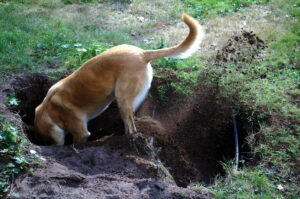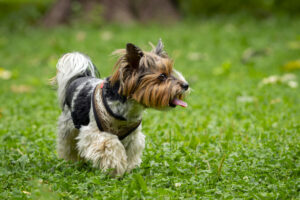Why Dog Trainers Put Treats In Their Mouth – finally explained! Dog training is an essential process every dog must undergo as it ensures that your dog has the correct behavior. It makes it easy for it to bond and become part of your family. Dog trainers are responsible for molding their behavior to fit the environment such as family dogs and police; some train their dogs to protect kids or help people with disabilities.
Although not all dog trainers put treats in their mouths, most do it to capture and maintain their dog’s attention. Most of the goodies include things that are edible such as hotdogs. You don’t have to eat it; hold it so the dog can see and then spit it out at the dog.
If the dog expects a treat, it’s hard to get distracted as their attention will always be on you.
Are you trying to train your dog to do a particular activity, have hit a snag, and don’t have the funds to hire a dog trainer?
Don’t worry; this piece will explain why dog trainers put treats in their mouths and how effectively they achieve the desired outcomes. You can also apply the same method to your dog. We’ve also provided a list of treats you can use when training your puppy.
4 Reasons Why Dog Trainers Put Treats In Their Mouth
- Why Dog Trainers Put Treats In Their Mouth Answer 1: To Maintain Their Attention
You may think it’s weird to put dog treats in your mouth, but it’s pretty standard. Each dog is different; while some are enamored by bright things such as toys, others are captivated by food. So ensure that you research what your dog is into and then work into having that treat every time you train your dog.
Most dog trainers cook what the dogs enjoy, such as chicken, hotdogs, cheese, or steak. They cut them up and store as much as possible in their mouth. When the dog knows the trainer has a treat in its mouth, it will focus on the trainer’s face. It makes it easy for them to listen and follow instructions.
A treat is not helpful if your dog doesn’t like it. Therefore, if your dogs are motivated by food, you must get them highly valued treats, not just some biscuit as they will get bored of it, and it does not have as much value to them as, say, a hotdog or piece of cheese.
Best High Value Cooked and Store Bought Dog Treat To Use During Training
| Cooked Dog Treats | Store-Bought Dog Treat Examples |
| Hotdog | Wellness Soft Puppies Bites |
| Sausage (mild) | Stewart Freeze-Dried Liver Dog Treats |
| Chicken | Blue Buffalo Blue Bits Savory Salmon Training Dog Treats |
| Beef | Wellness Core Pure Rewards Jerky Bites |
| Bacon (unsalted) | Old Mother Hubbard Classic Puppy Biscuits |
| Pork | Zuke’s Mini Natural Peanut Butter and Oats Training Treats |
Cooked dog treats are easily accessible as you can cook them in your kitchen or use the food that remains after your meals. Alternatively, you can purchase dog treats from the pet store.
- Why Dog Trainers Put Treats In Their Mouth Answer 2: Quick Access
Putting the dog treats in the mouth eliminates the possibility of stopping the training to grab the goodies. When the treats are in the mouth of the dog trainer, it makes it easy to spit them out to the dog promptly.. Some top handlers say that although you can put your goodies in your pocket, the mouth is the best as you do not have to fumble around as you locate the dog treat.
- Why Dog Trainers Put Treats In Their Mouth Answer 3: Teaching
If you are a dog person, you must have watched a dozen videos on dog training. You must have seen some trainers spit the treat at the dog and have it catch it before it hits the ground. It is a great way to keep the dog’s attention on you.
Dog trainers use treats to lure their dogs and reward them quickly. And you must use soft treats that won’t require your dog to use a lot of effort. For instance, it would be best to use chicken, cheese, or a hotdog instead of a biscuit.
A biscuit is crunchy and may disintegrate, forcing your dog to reach for the crumbs on the ground, thus distracting. Soft treats ensure you reward your dog’s performance quickly and ensure that they understand what you want.
- Why Dog Trainers Put Treats In Their Mouth Answer 4: Reward Good Behavior
Rewarding your dog’s excellent performance is always great by taking the treat out of your mouth. This way, the dog’s focus will always be on your face, guaranteeing success in your training. Sometimes you may find that your dog is not enamored by food; instead, they prefer toys. And some like to be praised or petted. Before embarking on dog training, research what type of reward your dog is into for successful results.
Do you like to make your own healthy dog treats, so you know what your dog is eating? Here’s my favorite recipe book for making dog treats my Tucker loves. Check the price here on Amazon.
Factors to Consider When Choosing Dog Treats For Training

When choosing dog treats, you must consider:
- The Treats Your Dog Likes
Ensure that your dog likes it because if it doesn’t, then the dog treat is useless. That is why most trainers choose to work with certified brands of dog treats or cooked treats acceptable to a wide variety of dogs.
- The Size Of The Treat
The smaller the size, the faster the dog will finish and resume training, but if the dog treat is enormous, your dog may become satiated after a few treats, thus putting a stop to the training. Using cooked treats, cut them up into small sizes to ensure that the training lasts longer since the rewards can last for a long time.
Therefore, dog trainers should get small-sized treats such as wellness Core Pure Rewards Jerky Bites to ensure that the training lasts longer and that the dog doesn’t get an upset stomach due to too much eating.
Other Helpful Methods
Dog Training requires patience, and you will need all the help you can get. So, besides treats, it is a good idea to check out these dog training apps, Goodpup, Pup to Date, Pupford Dog Training App, and Dogo.
Why Dog Trainers Put Treats In Their Mouth FAQs
Can You Give Treats Throughout The Day?
Treats reserved for training sessions are a great way to entice your dog to learn new tricks. So you can give treats throughout the day but only during training, which can happen at any time of the day. For instance, if you are walking your dog in the evening and want it to come to you, you can use a treat to lure it.
You must note that treats apply not only during formal training; you can give your dogs treats when they behave exceptional during the day. It ensures they know they have done a good thing and will maintain it.
Is There A Limit On The Number Of Treats A Dog Trainer Should Give Their Dogs?
Nutritional experts recommend that if you add anything to their diet, it should not exceed 10% of the calories each day. Therefore, if you provide your dog with 400 calories per day, ensure that the treats do not exceed 10%, equivalent to 40 calories.
Keep this in mind when planning which treats to use. That is why trainers use small-sized treats when training to avoid exceeding their calorie intake.
If the training takes a lot of time and the treats will not be enough, you can use part of the dog’s supper as treats. It ensures that you are staying on a diet and are not overfeeding the dog.
Since many treats can lead to an upset stomach, it is always best to monitor the treats given. You can also minimize the treats by using other rewards such as playtime, toys, praising, or petting them.
Do You Give Only One Type Of Dog Treat?
Dogs perform better when given one kind of dog treat throughout the whole training session and are just as excited with the tenth treat as they were with the first. However, some dogs are not enamored with one type of dog treat and tend to get bored quickly.
In this case, use different goodies; you can have cooked and non-cooked treats. It’s best to have good treats and extra special treats; the moment your dog realizes the difference, they will cooperate to get the extra special treats.
Check out Zak George’s Dog Training Revolution: Check the price here.
- Making A Cement or Concrete Dog House Foundation
- How Do Dogs Remember Where They Bury Bones? (Do They Remember)
- How Much Do Yorkies Cost? (An Amazingly Complete Guide For 2023)
- Can A Yorkie Be A Service Dog? Read This First!
- Walking Small Dogs Guide For Toy-Sized Breeds Like Yorkies (Best Distance, Length, and More)
- Karen Pryor, DON’T SHOOT the DOG: The Art of Teaching and Training. Simon and Schuster, 2019. https://books.google.co.ke/books?id=Sly8DwAAQBAJ&dq=why+dog+trainers+put+treats+in+their+mouths&lr=&source=gbs_navlinks_s. Accessed May 14, 2021.
- Evalyne Pang and Hilary Louie, Good Dog: Kids Teach Kids About Dog Behavior and Training, Dogwise Publishing, 2008. https://books.google.co.ke/books?id=ismv61uSz-sC&printsec=frontcover&dq=good+Dog:+Kids+teach+kids+about+Dog+behavior+and+training&hl=en&sa=X&ved=2ahUKEwi486KqvcnwAhWpyYUKHZ4mDR0Q6AEwAHoECAMQAg#v=onepage&q=good%20Dog%3A%20Kids%20teach%20kids%20about%20Dog%20behavior%20and%20training&f=false. Accessed May 14, 2021.





